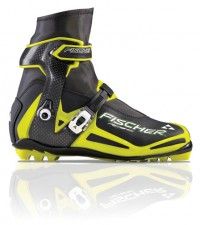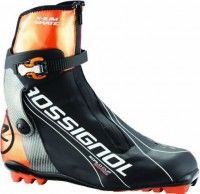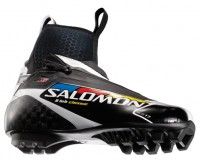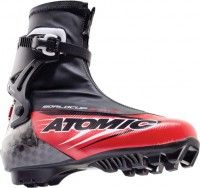October 12, 2010 – Better fit, lighter weight and superb performance define the new boots. Many were easy to spot on the feet of Olympians at the 2010 Games.
Fischer RCS Carbonlite Skating
Testers loved these boots. With lots of adjustment possible, they were able to fit all feet. The exoskeleton, internal torsion-control system and carbon cuff supplied loads of power and control. The soft inner boot felt cushy, even slipper-like in comfort. Because of a cantable cuff and well-designed footbed, balance was notably enhanced. This combo of great fit, easy balance and super power genuinely made skating easier.
Rossignol X-ium WC Skate
 Matched up with the new X-celerator binding and the new X-ium WC Skate ski, testers were impressed with the almost weightless feeling of this boot. The new asymmetrical lacing was easy to operate. The boots fit well right off the rack, but for people with difficult feet, the thermo adjustable feature allows precise fitting with the aid of a little heat. The ultra-lightweight carbon cuff and carbon heel counter provided plenty of power.
Matched up with the new X-celerator binding and the new X-ium WC Skate ski, testers were impressed with the almost weightless feeling of this boot. The new asymmetrical lacing was easy to operate. The boots fit well right off the rack, but for people with difficult feet, the thermo adjustable feature allows precise fitting with the aid of a little heat. The ultra-lightweight carbon cuff and carbon heel counter provided plenty of power.
Alpina CSK and CCL
We tested Alpina’s top-of-the-line race boot in 2009, and we noticed it on the feet of top Olympians in 2010. This year, the next three steps down (Competition Series, Race Series and the Sport Series) are all-new. The most notable feature of these boots is the new heel-grip system that looks sort of like a spur that ratchets up and down for more or less heel hold-down. We tested the Competition Series, both skate and classic. Great fit was the most-often-heard comment. The comfortable and neutral nature of these boots made them a favourite to use while testing skis. Power and balance was right there when you needed it in skating. The Classic boots had a nice smooth flex enhancing the grip phase while striding.

![]() Salomon S-Lab Classic boot and Propulse binding
Salomon S-Lab Classic boot and Propulse binding
Salomon has always produced great-fitting classic boots, and the new S-Lab Classic continues the tradition. New is the adjustable heel strap with a spoiler (a small plastic piece that cups the lower Achilles tendon) and an adjustment window to easily see and adjust the strap. We didn’t feel the strap when skiing, but heel hold-down was exceptional. The boot is designed to fit the new Propulse binding and features the pivot point 17mm back from the toe of the boot. This pivot placement is meant to provide a more natural feel, but since the boot sole flexed so nicely, quite frankly, most testers didn’t notice this change. The boot sole still has two bars and is compatible with Salomon’s Pilot bindings. In past tests, SkiTrax loved the wonderful, natural feel of the classic Pilot binding and the lack of a toe bumper. However, in some snow conditions, the fibre strap on the Pilot bindings iced up. So Salomon developed the Propulse binding and brought the toe bumper back. We found the new binding super-light and easy to use. Many testers liked the way the binding allowed the boot to be right on the ski instead of lifted above it. They felt more sensitive to the ski and wax and hence able to get a better grip. But even though the new toe bumper is small and well-placed, it was noticeable.
 Atomic Worldcup Skate
Atomic Worldcup Skate
Clean, simple and comfortable is how most testers found these all-new boots from Atomic. They are based on the Salomon Pilot chassis, with the pivot point placed 17mm back from the toe. The cuff looks like a Salomon Energizer cuff with the bottom cut off — in fact, that is exactly what it is. The advantage is more fore-and-aft ankle flexibility. The disadvantage is there is no help from the boot in keeping the ski tip up. We found that the boot had lots of power and didn’t notice any problem with the ski tip on foot return. It was easy to find the optimum place to stand on a variety of skis, and the boots remained very comfortable all day long.





